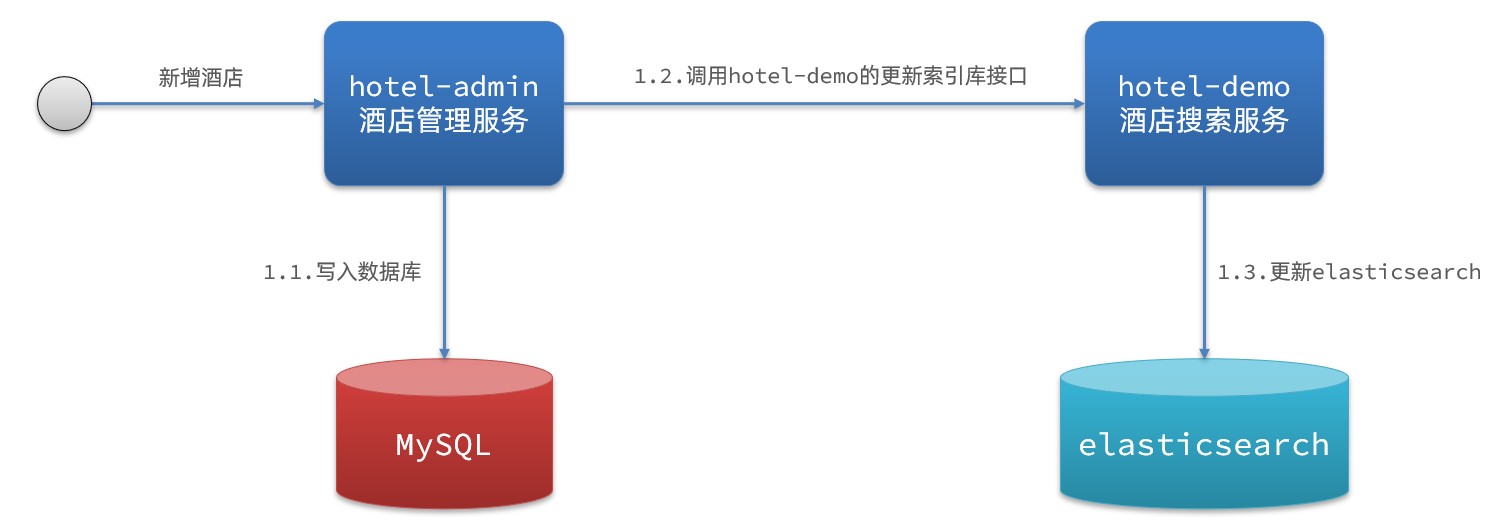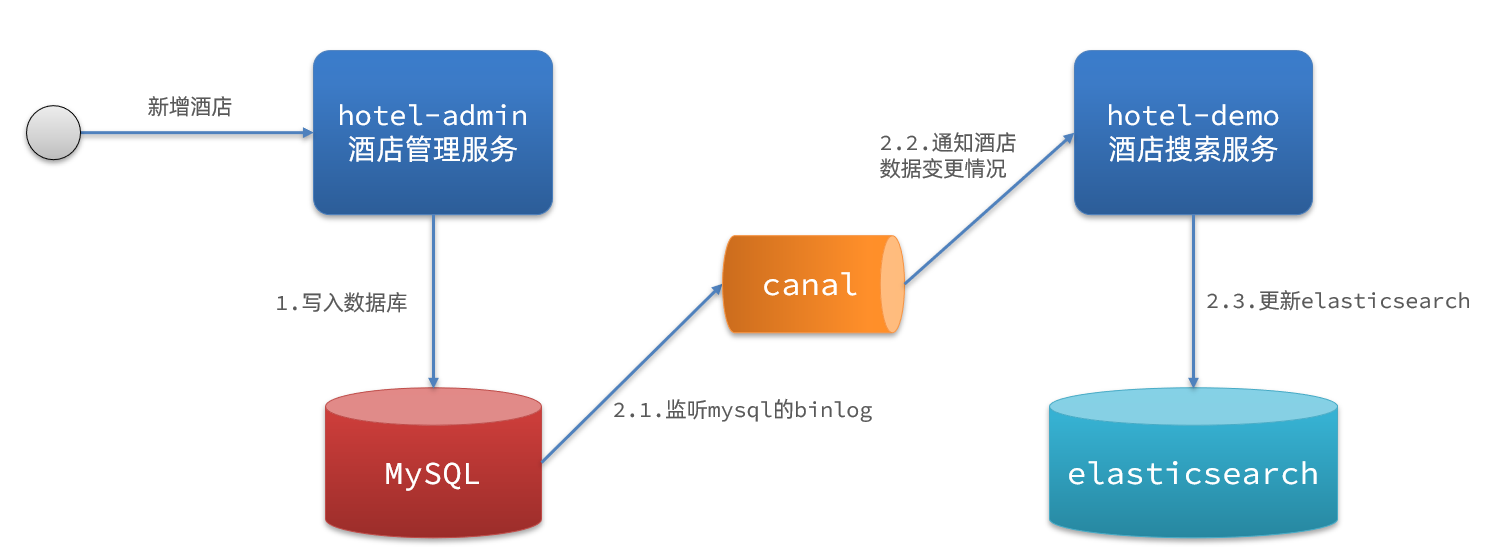elasticsearch中的酒店数据来自于mysql数据库,因此mysql数据发生改变时,elasticsearch也必须跟着改变,这个就是elasticsearch与mysql之间的 数据同步。
在微服务中,负责酒店管理(操作mysql )的业务与负责酒店搜索(操作elasticsearch )的业务可能在两个不同的微服务上,数据同步该如何实现呢?
思路分析
常见的数据同步方案有三种:
同步调用

- hotel-demo对外提供接口,用来修改elasticsearch中的数据
- 酒店管理服务在完成数据库操作后,直接调用hotel-demo提供的接口
- 优点:实现简单,粗暴
- 缺点:业务耦合度高
异步通知

- hotel-admin对mysql数据库数据完成增、删、改后,发送MQ消息
- hotel-demo监听MQ,接收到消息后完成elasticsearch数据修改
监听binlog

实现数据同步
思路
hotel-admin项目作为酒店管理的微服务。当酒店数据发生增、删、改时,要求对elasticsearch中数据也要完成相同操作。
导入hotel-admin项目,启动并测试酒店数据的CRUD
声明exchange、queue、RoutingKey
在hotel-admin中的增、删、改业务中完成消息发送
在hotel-demo中完成消息监听,并更新elasticsearch中数据
启动并测试数据同步功能
声明交换机、队列
MQ结构如图:

在hotel-admin、hotel-demo中引入rabbitmq的依赖:
1
2
3
4
5
|
<dependency>
<groupId>org.springframework.boot</groupId>
<artifactId>spring-boot-starter-amqp</artifactId>
</dependency>
|
声明队列交换机名称
在hotel和hotel-admin中
1
2
3
4
5
6
7
8
9
10
11
12
13
14
15
16
17
18
19
20
21
22
| public class MqConstants {
public final static String HOTEL_EXCHANGE = "hotel.topic";
public final static String HOTEL_INSERT_QUEUE = "hotel.insert.queue";
public final static String HOTEL_DELETE_QUEUE = "hotel.delete.queue";
public final static String HOTEL_INSERT_KEY = "hotel.insert";
public final static String HOTEL_DELETE_KEY = "hotel.delete";
}
|
声明队列交换机
在hotel-demo中,定义配置类,声明队列、交换机:
1
2
3
4
5
6
7
8
9
10
11
12
13
14
15
16
17
18
19
20
21
22
23
24
25
26
27
| @Configuration
public class MqConfig {
@Bean
public TopicExchange topicExchange(){
return new TopicExchange(MqConstants.HOTEL_EXCHANGE, true, false);
}
@Bean
public Queue insertQueue(){
return new Queue(MqConstants.HOTEL_INSERT_QUEUE, true);
}
@Bean
public Queue deleteQueue(){
return new Queue(MqConstants.HOTEL_DELETE_QUEUE, true);
}
@Bean
public Binding insertQueueBinding(){
return BindingBuilder.bind(insertQueue()).to(topicExchange()).with(MqConstants.HOTEL_INSERT_KEY);
}
@Bean
public Binding deleteQueueBinding(){
return BindingBuilder.bind(deleteQueue()).to(topicExchange()).with(MqConstants.HOTEL_DELETE_KEY);
}
}
|
发送MQ消息
在hotel-admin中的增、删、改业务中分别发送MQ消息:

接收MQ消息
hotel-demo接收到MQ消息要做的事情包括:
- 新增消息:根据传递的hotel的id查询hotel信息,然后新增一条数据到索引库
- 删除消息:根据传递的hotel的id删除索引库中的一条数据
在hotel-demoIHotelService中新增新增、删除业务
1
2
3
| void deleteById(Long id);
void insertById(Long id);
|
给hotel-demo中的HotelService中实现业务:
1
2
3
4
5
6
7
8
9
10
11
12
13
14
15
16
17
18
19
20
21
22
23
24
25
26
27
28
29
30
| @Override
public void deleteById(Long id) {
try {
DeleteRequest request = new DeleteRequest("hotel", id.toString());
client.delete(request, RequestOptions.DEFAULT);
} catch (IOException e) {
throw new RuntimeException(e);
}
}
@Override
public void insertById(Long id) {
try {
Hotel hotel = getById(id);
HotelDoc hotelDoc = new HotelDoc(hotel);
IndexRequest request = new IndexRequest("hotel").id(hotel.getId().toString());
request.source(JSON.toJSONString(hotelDoc), XContentType.JSON);
client.index(request, RequestOptions.DEFAULT);
} catch (IOException e) {
throw new RuntimeException(e);
}
}
|
编写监听器
1
2
3
4
5
6
7
8
9
10
11
12
13
14
15
16
17
18
19
20
21
22
23
24
| @Component
public class HotelListener {
@Autowired
private IHotelService hotelService;
@RabbitListener(queues = MqConstants.HOTEL_INSERT_QUEUE)
public void listenHotelInsertOrUpdate(Long id){
hotelService.insertById(id);
}
@RabbitListener(queues = MqConstants.HOTEL_DELETE_QUEUE)
public void listenHotelDelete(Long id){
hotelService.deleteById(id);
}
}
|















